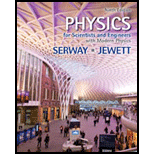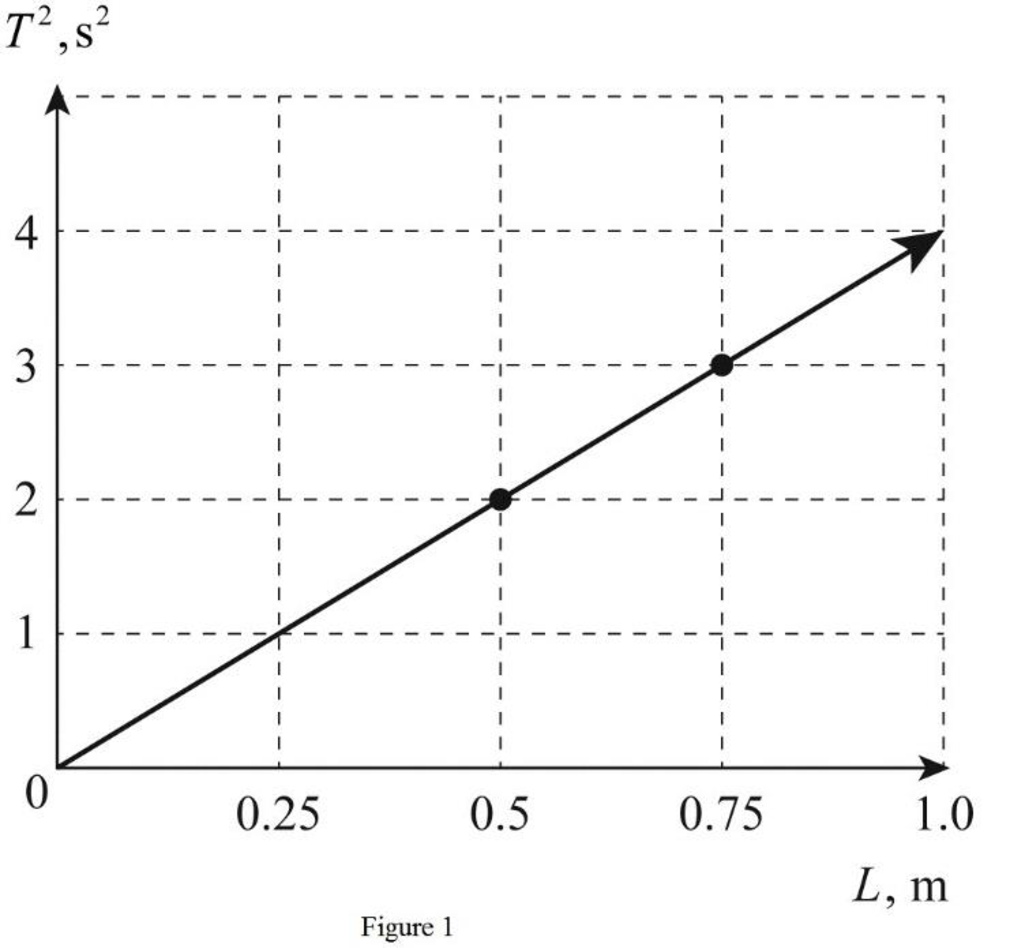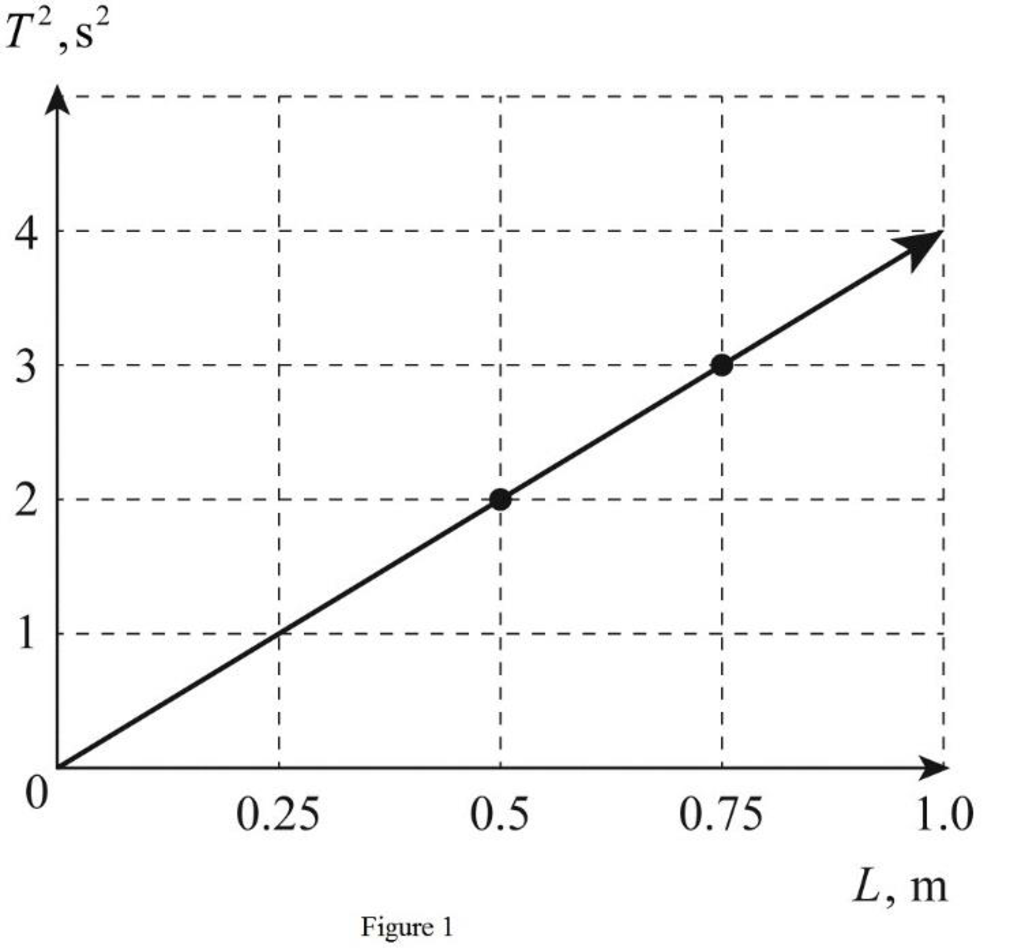
Concept explainers
(a)
The period of motion of pendulum for each lengths.
(a)
Answer to Problem 44P
The period of motion for length
Explanation of Solution
Write the expression for the time period of oscillation of a simple pendulum.
Here,
Conclusion:
Consider simple pendulum of length
Substitute
Consider simple pendulum of length
Substitute
Consider simple pendulum of length
Substitute
Tabulated form of the length of pendulum and the corresponding time periods is shown in Table 1 below.

Therefore, the period of motion for length
(b)
The average value of
(b)
Answer to Problem 44P
The average value of
Explanation of Solution
Write the expression for the time period of the simple pendulum.
Here,
Square expression (II) and rearrange to find
Write the expression to find the average acceleration due to gravity.
Here,
Write the expression to find the degree of closeness of the average value to the accepted value of acceleration due to gravity.
Here,
Conclusion:
Consider simple pendulum of length
Substitute
Consider simple pendulum of length
Substitute
Consider simple pendulum of length
Substitute
The tabulate form of values of time period, length and acceleration due to gravity is given in Table 2 below.

Substitute
Substitute
Therefore, the average value of
(c)
Plot
(c)
Answer to Problem 44P
Figure 1 gives the plot between

Explanation of Solution
From Table 2 obtain the values for length of pendulums and the corresponding time period of oscillations. Find the value of
Plot

Write the expression for
From equation (VI), slope of the graph is
Here,
Rearrange expression (VII) to find
Conclusion:
The slope of graph is got as
Therefore, Figure 1 gives the plot between
(d)
The level of closeness of
(d)
Answer to Problem 44P
The value of
Explanation of Solution
Write the expression to find the level of closeness of acceleration due to gravity from graph and accepted value of
Here,
Conclusion:
Substitute
Therefore, the value of
Want to see more full solutions like this?
Chapter 15 Solutions
Physics for Scientists and Engineers With Modern Physics
- We do not need the analogy in Equation 16.30 to write expressions for the translational displacement of a pendulum bob along the circular arc s(t), translational speed v(t), and translational acceleration a(t). Show that they are given by s(t) = smax cos (smpt + ) v(t) = vmax sin (smpt + ) a(t) = amax cos(smpt + ) respectively, where smax = max with being the length of the pendulum, vmax = smax smp, and amax = smax smp2.arrow_forwardFor each expression, identify the angular frequency , period T, initial phase and amplitude ymax of the oscillation. All values are in SI units. a. y(t) = 0.75 cos (14.5t) b. vy (t) = 0.75 sin (14.5t + /2) c. ay (t) = 14.5 cos (0.75t + /2) 16.3arrow_forwardIn an engine, a piston oscillates with simple harmonic motion so that its position varies according to the expression x=5.00cos(2t+6) where x is in centimeters and t is in seconds. At t = 0, find (a) the position of the piston, (b) its velocity, and (c) its acceleration. Find (d) the period and (e) the amplitude of the motion.arrow_forward
- A grandfather clock has a pendulum length of 0.7 m and mass bob of 0.4 kg. A mass of 2 kg falls 0.8 m in seven days to keep the amplitude (from equilibrium) of the pendulum oscillation steady at 0.03 rad. What is the Q of the system?arrow_forwardWhich of the following statements is not true regarding a massspring system that moves with simple harmonic motion in the absence of friction? (a) The total energy of the system remains constant. (b) The energy of the system is continually transformed between kinetic and potential energy. (c) The total energy of the system is proportional to the square of the amplitude. (d) The potential energy stored in the system is greatest when the mass passes through the equilibrium position. (e) The velocity of the oscillating mass has its maximum value when the mass passes through the equilibrium position.arrow_forwardIf the speed of the observer is increased by 5.0%, what is the period of the pendulum when measured by this observer?arrow_forward
- If a simple pendulum oscillates with small amplitude and its length is doubled, what happens to the frequency of its motion? (a) It doubles. (b) It becomes 2 times as large. (c) It becomes half as large. (d) It becomes 1/2 times as large. (e) It remains the same.arrow_forwardThe amplitude of a lightly damped oscillator decreases by 3.0% during each cycle. What percentage of the mechanical energy of the oscillator is lost in each cycle?arrow_forwardAn object of mass m is hung from a spring and set into oscillation. The period of the oscillation is measured and recorded as T. The object of mass m is removed and replaced with an object of mass 2m. When this object is set into oscillation, what is the period of the motion? (a) 2T (b) 2T (c) T (d) T/2 (e) T/2arrow_forward
- An object of mass m moves in simple harmonic motion with amplitude 12.0 cm on a light spring. Its maximum acceleration is 108 cm/s2. Regard m as a variable. (a) Find the period T of the object. (b) Find its frequency f. (c) Find the maximum speed vmax of the object. (d) Find the total energy E of the objectspring system. (e) Find the force constant k of the spring. (f) Describe the pattern of dependence of each of the quantities T, f, vmax, E, and k on m.arrow_forwardThe total energy of a simple harmonic oscillator with amplitude 3.00 cm is 0.500 J. a. What is the kinetic energy of the system when the position of the oscillator is 0.750 cm? b. What is the potential energy of the system at this position? c. What is the position for which the potential energy of the system is equal to its kinetic energy? d. For a simple harmonic oscillator, what, if any, are the positions for which the kinetic energy of the system exceeds the maximum potential energy of the system? Explain your answer. FIGURE P16.73arrow_forwardAn automobile with a mass of 1000 kg, including passengers, settles 1.0 cm closer to the road for every additional 100 kg of passengers. It is driven with a constant horizontal component of speed 20 km/h over a washboard road with sinusoidal bumps. The amplitude and wavelength of the sine curve are 5.0 cm and 20 cm, respectively. The distance between the front and back wheels is 2.4 m. Find the amplitude of oscillation of the automobile, assuming it moves vertically as an undamped driven harmonic oscillator. Neglect the mass of the wheels and springs and assume that the wheels are always in contact with the road.arrow_forward
 Principles of Physics: A Calculus-Based TextPhysicsISBN:9781133104261Author:Raymond A. Serway, John W. JewettPublisher:Cengage Learning
Principles of Physics: A Calculus-Based TextPhysicsISBN:9781133104261Author:Raymond A. Serway, John W. JewettPublisher:Cengage Learning Physics for Scientists and EngineersPhysicsISBN:9781337553278Author:Raymond A. Serway, John W. JewettPublisher:Cengage Learning
Physics for Scientists and EngineersPhysicsISBN:9781337553278Author:Raymond A. Serway, John W. JewettPublisher:Cengage Learning Physics for Scientists and Engineers with Modern ...PhysicsISBN:9781337553292Author:Raymond A. Serway, John W. JewettPublisher:Cengage Learning
Physics for Scientists and Engineers with Modern ...PhysicsISBN:9781337553292Author:Raymond A. Serway, John W. JewettPublisher:Cengage Learning Physics for Scientists and Engineers: Foundations...PhysicsISBN:9781133939146Author:Katz, Debora M.Publisher:Cengage Learning
Physics for Scientists and Engineers: Foundations...PhysicsISBN:9781133939146Author:Katz, Debora M.Publisher:Cengage Learning Classical Dynamics of Particles and SystemsPhysicsISBN:9780534408961Author:Stephen T. Thornton, Jerry B. MarionPublisher:Cengage Learning
Classical Dynamics of Particles and SystemsPhysicsISBN:9780534408961Author:Stephen T. Thornton, Jerry B. MarionPublisher:Cengage Learning University Physics Volume 1PhysicsISBN:9781938168277Author:William Moebs, Samuel J. Ling, Jeff SannyPublisher:OpenStax - Rice University
University Physics Volume 1PhysicsISBN:9781938168277Author:William Moebs, Samuel J. Ling, Jeff SannyPublisher:OpenStax - Rice University





